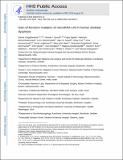Gain-of-function mutation of microRNA-140 in human skeletal dysplasia
Author(s)
Suzuki, Hiroshi I.; Sharp, Phillip A.
DownloadAccepted version (2.749Mb)
Publisher Policy
Publisher Policy
Article is made available in accordance with the publisher's policy and may be subject to US copyright law. Please refer to the publisher's site for terms of use.
Terms of use
Metadata
Show full item recordAbstract
MicroRNAs (miRNAs) are post-transcriptional regulators of gene expression. Heterozygous loss-of-function point mutations of miRNA genes are associated with several human congenital disorders 1–5 , but neomorphic (gain-of-new-function) mutations in miRNAs due to nucleotide substitutions have not been reported. Here we describe a neomorphic seed region mutation in the chondrocyte-specific, super-enhancer-associated MIR140 gene encoding microRNA-140 (miR-140) in a novel autosomal dominant human skeletal dysplasia. Mice with the corresponding single nucleotide substitution show skeletal abnormalities similar to those of the patients but distinct from those of miR-140-null mice 6 . This mutant miRNA gene yields abundant mutant miR-140-5p expression without miRNA-processing defects. In chondrocytes, the mutation causes widespread derepression of wild-type miR-140-5p targets and repression of mutant miR-140-5p targets, indicating that the mutation produces both loss-of-function and gain-of-function effects. Furthermore, the mutant miR-140-5p seed competes with the conserved RNA-binding protein Ybx1 for overlapping binding sites. This finding may explain the potent target repression and robust in vivo effect by this mutant miRNA even in the absence of evolutionary selection of miRNA–target RNA interactions, which contributes to the strong regulatory effects of conserved miRNAs 7,8 . Our study presents the first case of a pathogenic gain-of-function miRNA mutation and provides molecular insight into neomorphic actions of emerging and/or mutant miRNAs.
Date issued
2019-02-25Department
Massachusetts Institute of Technology. Department of Biology; Koch Institute for Integrative Cancer Research at MITJournal
Nature medicine
Publisher
Springer Science and Business Media LLC
Citation
Grigelioniene, Giedre et al. "Gain-of-function mutation of microRNA-140 in human skeletal dysplasia." Nature medicine 25 (2019): 583-590 © 2019 The Author(s)
Version: Author's final manuscript
ISSN
1078-8956
1546-170X
Keywords
General Biochemistry, Genetics and Molecular Biology, General Medicine